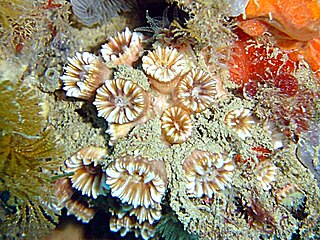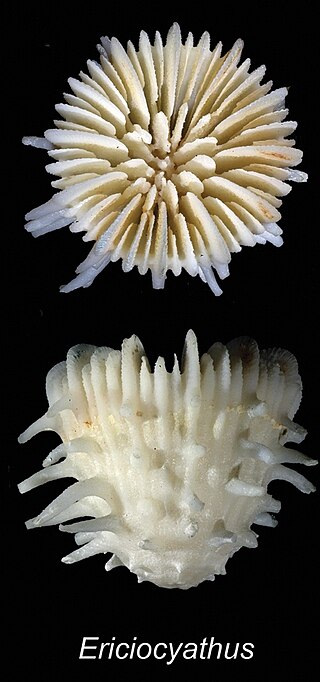
Madrepora is a genus of stony corals, often found forming reefs or islands in tropical locations. The names Madrepore and Madreporaria were formerly applied universally to any stony coral of the family Scleractinia. They reproduce in three separate ways, as discovered by the marine zoologist Anne Thynne (1800–1866). It is commonly known as horn coral. A colony is branched with small polyps in cylindrical cups separated by a perforated coenosteum. Terminal polyps bear six tentacles, while lateral polyps bear twelve tentacles. Madrepora is economically important, since it contributes to the formation of coral reefs.

The Serpulidae are a family of sessile, tube-building annelid worms in the class Polychaeta. The members of this family differ from other sabellid tube worms in that they have a specialized operculum that blocks the entrance of their tubes when they withdraw into the tubes. In addition, serpulids secrete tubes of calcium carbonate. Serpulids are the most important biomineralizers among annelids. About 300 species in the family Serpulidae are known, all but one of which live in saline waters. The earliest serpulids are known from the Permian, and possibly the upper Permian south China

The Caryophylliidae are a family of stony corals found from the tropics to temperate seas, and from shallow to very deep water.

Balanophyllia is a genus of solitary corals in the order of stony corals.

Stylasteridae, also known as lace corals, is a family of colonial hydrozoans with a calcified skeleton. They first appeared 65 million years ago in deep waters. About 10% of the species have adapted to shallow water. In shallow reefs they can grow up to 25 cm tall × 30 cm wide, but some species in deeper waters can reach 1 meter.

Stylaster is a genus of hydroids in the family Stylasteridae.

Leptopsammia is a genus of stony cup corals in the family Dendrophylliidae. Members of this genus are found at depths down to about 900 metres (3,000 ft). They are azooxanthellate, meaning that they do not contain symbiotic photosynthetic algae as do many species of coral.

Dendrophyllia is a genus of stony cup corals in the family Dendrophylliidae. Members of this genus are found at depths down to about 900 metres (3,000 ft). They are azooxanthellate corals, meaning that they do not contain symbiotic photosynthetic dinoflagellates as do many species of coral.

Heterocyathus is a genus of coral of the family Caryophylliidae.
Ciocalypta is a genus of sea sponges belonging to the family Halichondriidae.
Asbestopluma is a genus of sponges belonging to the family Cladorhizidae.

Madracis is a genus of cnidarians belonging to the family Pocilloporidae. The genus has a cosmopolitan distribution.

Ericiocyathus is a genus of cnidarians belonging to the family Caryophylliidae.

Aulocyathus is a genus of cnidarians belonging to the family Caryophylliidae.

Fungiacyathus is a genus of corals belonging to the monotypic family Fungiacyathidae.
Vermiliopsis is a genus of polychaetes belonging to the family Serpulidae.

Endopachys is a genus of corals belonging to the family Dendrophylliidae.
Inferiolabiata is a genus of hydrozoans belonging to the family Stylasteridae.
Euryspongia is a genus of sponges belonging to the family Dysideidae.

Schizoretepora is a genus of bryozoans belonging to the family Phidoloporidae.















